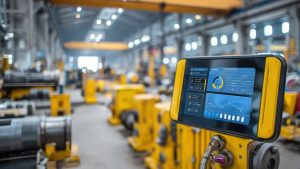AI Solutions for Maintenance & Engineering Teams
Maintenance groups often struggle with information gaps that avert performance and choice-making. Outdated documentation, complicated gadget records, and group worker turnover exacerbate these challenges, potentially inflicting highly priced unplanned downtime and ignored opportunities. However, the integration of AI solutions for maintenance & engineering teams is rapidly transforming how these obstacles are addressed. AI can bridge know-how gaps, optimize protection exercises, and offer actual-time actionable insights. By leveraging AI’s abilities, maintenance teams can decorate predictive protection, automate diagnostic processes, and make more knowledgeable choices quickly. As a result, AI offers new requirements for efficiency, reliability, and value-effectiveness in business settings, paving the way for an extra-streamlined, records-driven technique for renovation management.
Table of Contents:
- AI Solutions for Maintenance & Engineering Teams
- The Knowledge Gap in Maintenance: A Persistent Challenge
- How AI Bridges the Gap
- Real-World Applications of AI in Maintenance
- Overcoming Implementation Challenges
- The Future of AI in Maintenance and Engineering
- Conclusion
The Knowledge Gap in Maintenance: A Persistent Challenge
The knowledge gap in maintenance affects many industries. This gap appears in several ways:
- Outdated documentation that doesn’t reflect current technology.
- Unstructured data spread across various systems.
- Loss of institutional knowledge due to employee turnover.
These factors create inefficiency, leading to slower choices and extra downtime. Unplanned downtime charges producers a mean of $260,000 per hour, highlighting the want for a higher upkeep solution.
How AI Bridges the Gap
AI solutions provide a powerful way to tackle these persistent maintenance issues. AI is transforming the maintenance landscape through improved maintenance methods and equipment condition monitoring.
Unifying Data for Actionable Insights
AI excels at organizing and interpreting complex machine data. AI systems analyze vast amounts of information, from maintenance logs and sensor data, turning it into actionable insights. This empowers maintenance activities with contextual data, helping maintenance and engineering teams analyze data effectively.
For example, AI can predict failures by analyzing maintenance records and equipment performance. This proactive approach addresses issues before escalate, reducing downtime and costs. The availability of improved maintenance methods empowers maintenance and engineering teams to prevent asset failures.
Faster Problem-Solving with Predictive Analytics
AI-powered predictive maintenance transforms equipment upkeep. Using machine learning algorithms, these systems:
- Analyze patterns in equipment performance.
- Predict failures accurately.
- Recommend ideal maintenance schedules.
This method is very effective. AI-more desirable predictive protection leads to a 70% reduction in breakdowns and a 10-20% boom in uptime. This manner huge value financial savings and higher operational efficiency. This maintenance strategy offers an alternative to traditional maintenance.
Knowledge Retention and Continuity
AI acts as a centralized knowledge base. This helps industries with high turnover or retiring workforces. By capturing institutional knowledge, AI maintains consistent practices despite changing team compositions. New hires get up to speed faster using the AI system.
Real-World Applications of AI in Maintenance
AI adoption in maintenance is increasing across industries. AI-based solutions help predict equipment failures for manufacturing operations. Manufacturing teams can now streamline renovation, avoid unplanned downtime, and predict disasters in numerous programs.
Manufacturing: Optimizing Production and Reducing Downtime
AI improves manufacturing by optimizing production and lowering unplanned downtime. Manufacturing flora with the use of AI for predictive upkeep sees as much as 30% higher uptime. This increased efficiency saves money and increases productivity. AI helps anticipate failures to reduce downtime.
AI continuously monitors equipment, alerting teams to problems before they cause full-blown failures. This extends the machine’s lifespan. AI-based predictive maintenance assists by anticipating and helping to prevent equipment failures for reduced costs.
Energy Sector: Enhancing Efficiency and Safety
In energy, AI improves efficiency and safety. AI solutions ensure:
- Real-time power grid performance monitoring.
- Predicting outages and failures.
- Optimizing energy distribution.
This increases service reliability and improves safety by identifying potential hazards. These capabilities contribute to a higher level of workplace safety for the whole team.
Facilities Management: Smart Building Maintenance
AI is changing building maintenance. AI-based management systems improve building energy efficiency by 30%, reducing costs and environmental impact.
These systems:
- Monitor and adjust HVAC systems.
- Predict maintenance needs for elevators and lighting.
- Optimize space use based on occupancy.
These advanced analytics features reduce downtime while analyzing and processing repetitive tasks for improved efficiency.
Overcoming Implementation Challenges
While beneficial, AI implementation can be challenging. Let’s consider common hurdles and their solutions.
Data Quality and Integration
AI effectiveness depends on quality data. Many struggle with:
- Inconsistent data formats.
- Incomplete historical data.
- Siloed information.
Companies should prioritize data cleaning and integration, perhaps investing in data management tools and standardizing data collection. Machine learning algorithms analyze data more efficiently with higher-quality data.
Workforce Adaptation and Training
Implementing AI often changes how teams work. Resistance to change or fear of technology is common. To help, organizations should:
- Provide comprehensive training.
- Emphasize how AI augments, not replaces, human expertise.
- Involve the team to gain buy-in.
These tactics support implementing AI-based machine learning solutions for maintenance teams. By understanding how machine learning algorithms improve efficiency and accuracy in daily maintenance tasks, workers can transition to AI with increased confidence.
Cost Considerations
The initial AI investment can seem high, but consider long-term benefits.
Cost Factor Potential Savings
Reduced downtime Up to $260,000 per hour in manufacturing
Improved energy efficiency 30% reduction in building energy costs
Extended equipment lifespan: 10-20% increase in equipment uptime
Focus on these potential savings when building a business case for AI. These advanced artificial intelligence applications save organizations time and resources while optimizing maintenance routines.
The Future of AI in Maintenance and Engineering
AI’s role in maintenance will grow. Some advancements on the horizon are the increased ability to analyze large datasets from equipment maintenance data and new learning algorithms.
Integration with IoT and Edge Computing
Combining AI with IoT devices and edge computing creates better predictive maintenance. Processing data closer to the source enables near-real-time insights and faster response times.
Advanced Natural Language Processing
Better natural language processing will make AI more accessible. AI-powered voice transcription allows easier interaction, streamlining workflows, and reducing administrative burdens. Artificial intelligence advanced systems now improve maintenance strategies and machine performance insights.
Generative AI for Maintenance Planning
Generative AI can create custom maintenance plans and operating procedures. By analyzing data, these systems generate optimized schedules, enhancing efficiency.
Conclusion
AI solutions for maintenance teams are transforming industries. By bridging knowledge gaps and enabling predictive maintenance, these technologies drive efficiency and reliability. As demonstrated, AI offers significant benefits, from cost savings to improved safety and equipment lifespans.
Challenges exist, but the rewards of AI implementation outweigh the difficulties. AI’s role in maintenance will become more critical. Companies adopting AI will gain an aggressive benefit, with accelerated efficiency and optimized operations.
As AI continues to adapt, it’s vital to cope with frequently asked questions regarding its utility. One of the most commonplace queries revolves around the initial fees of implementation. While adopting AI may also require in-progress investments, the lengthy-time period benefits—which include reduced power consumption, fewer machine failures, and fewer unplanned downtimes—speedily offset the initial costs.
The integration of AI in maintenance management can also undoubtedly impact the delivery chain, optimizing stock levels, predicting part disasters, and ensuring well-timed replacements. This leads to smoother operations and reduces costly disruptions in the overall supply chain.
Additionally, success stories from companies already leveraging AI show significant improvements in operational performance, including enhanced energy consumption monitoring and waste reduction. Maintenance teams are more proactive rather than reactive, helping them prevent failures before they occur, which saves both time and money.
In conclusion, AI offers a transformative approach to maintenance management. By leveraging AI tools, businesses can look forward to more efficient workflows, improved safety measures, and better resource management, ensuring sustainability and growth for years to come.



